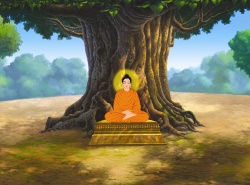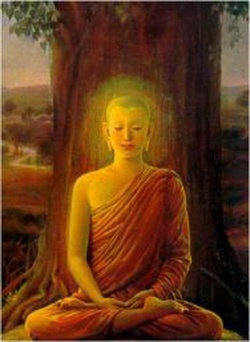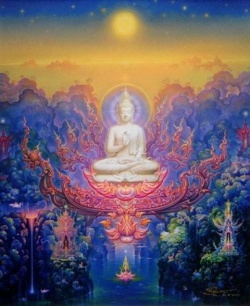Alara Kalama
Alara Kalama
阿羅邏5藍 (Pali; Skt Arada Kalama; Jpn Arara-karan) Alara-Kalama
Alara-Kalama in Pali, Arada-Kalama in Sanskrit. A sage under whom Shakyamuni studied meditation. The state reached by Alara-Kalama was that of a higher formless world where matter no longer exists.
A hermit-sage and master of yogic meditation who lived near Rajagriha (Vaishali, according to another account) in ancient India. He is said to have mastered the meditation on the Realm of Nothingness. He was the first teacher under whom Shakyamuni studied and practiced after renouncing the secular world. Shakyamuni quickly mastered the same meditation but, unable to gain the enlightenment he had sought, left Alara Kalama.
Alara Kalama was one of the teachers Siddhattha studied under and practiced austerities with in his efforts toward enlightenment. Alara Kalama and Siddhattha attained to high levels of jhana, but no ultimate insight of enlightenment.
How the Bodhisatta took instructions from the holy sage Alara was described thus:
"Having gone forth and become a recluse in pursuit of what is holy and good, seeking the supreme, incomparable Peace of nibbāna , I drew to where Alara Kalama was and addressed him thus: 'Friend Kalama, I desire to lead the holy life under your doctrine and discipline.' When I had thus addressed him, Alara replied, 'The Venerable friend Gotama is welcome to remain in this teaching. Of such a nature is this dhamma that in a short time an intelligent man can realize for himself and abide in possession of what his teacher has realized as his own.'"
After these words of encouragement, Alara gave him practical instructions on the doctrine.
Alara's statement that his Dhamma, if practised as taught, could be realized soon by oneself as one's own was very reassuring and inspired confidence. A pragmatic doctrine is trustworthy and convincing only if it could be realized by oneself and in a short time. The sooner the realization is possible, the more heartening it will be. The Bodhisatta was thus satisfied with Alara's words and this thought arose in him:
"It is not by mere faith that Alara announces that he has learned the Dhamma. Alara has surely realized the Dhamma himself, he knows and understands it."
That was very true. Alara did not cite any texts as authority. He did not say that he had heard it from others. He clearly stated that what he knew personally he had realized it himself. A meditation teacher must be able to declare his conviction boldly like him. Without having practised the dhamma personally, without having experienced and realized it in a personal way, to claim to be a teacher in meditation, to preach and write books about it after just learning from the texts on meditation methods is most incongruous and improper. It is like a physician prescribing medicine not yet clinically tested and tried by him, and which he dared not administer on himself. Such preachments and publications are surely undependable and uninspiring.
But Alara taught boldly what he had realized himself. The Bodhisatta was fully impressed by him and this thought arose in him:
"Not only Alara has faith, I also have faith. Not only Alara has energy, mindfulness, concentration, wisdom, I also have them."
Then he strove for the realization of that Dhamma which Alara declared that he himself had learned and realized. In no time, the Bodhisatta learned the Dhamma which led him as far as the jhanic realm of Nothingness.
He then approached where Alara Kalama was and enquired of him whether the realm of Nothingness, which the latter had claimed to have realized it himself and lived in possession of, was the same stage as what the Bodhisatta had now reached. Alara replied,
"This is as far as the Dhamma leads, of which I have declared that I have realized and abide in its possession, the same stage as friend Gotama has reached."
Then he utter these words of praise,
"Friend Gotama is a supremely distinguished person. The realm of Nothingness is not easily attainable yet Friend Gotama has realized it in no time. It is truly wonderful. Fortunate are we that we should light upon such a distinguished ascetic companion as your Reverence. As I have realized the Dhamma, so have you realized it, too. As you have learnt it, so have I learnt to the same extent as you. Friend Gotama is my equal in Dhamma. We have a large community here. Come, friend, together let us direct this company of disciples."
Thus Alara, the teacher, set up the Bodhisatta, his pupil, as completely equal to himself and honoured him by delegating to him the task of guiding one hundred and fifty pupils, which number was exactly half of all the disciples Alara had.
But the Bodhisatta stayed at the centre only for a short time. While staying there this thought came to him:
"This doctrine does not lead to aversion, to abatement and cessation of passion, to quiescence for higher knowledge and full enlightenment nor to nibbāna , the end of sufferings, but only as far as the attainment to the realm of Nothingness. Once there, a long life of 60,000 world cycles follows, and after expiring from there, one reappears in the Kamma existences and goes through the sufferings again. It is not the doctrine of the undying that I am looking for."
Thus becoming indifferent to the practice which led only to the jhanic realm of Nothingness (the seventh jhana, if you count the formless realms as the Jhanas), the Bodhisatta abandoned it and departed from Alara's meditation center.
After the Buddha's enlightenment he looked for his former teachers (Alara Kalama and Udaka Ramaputta), but they had already passed away.


